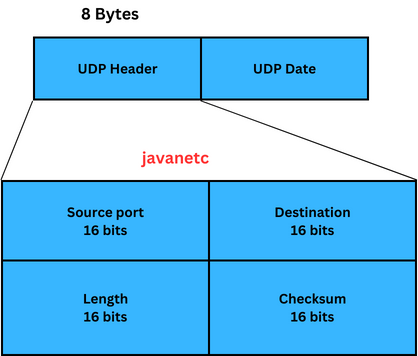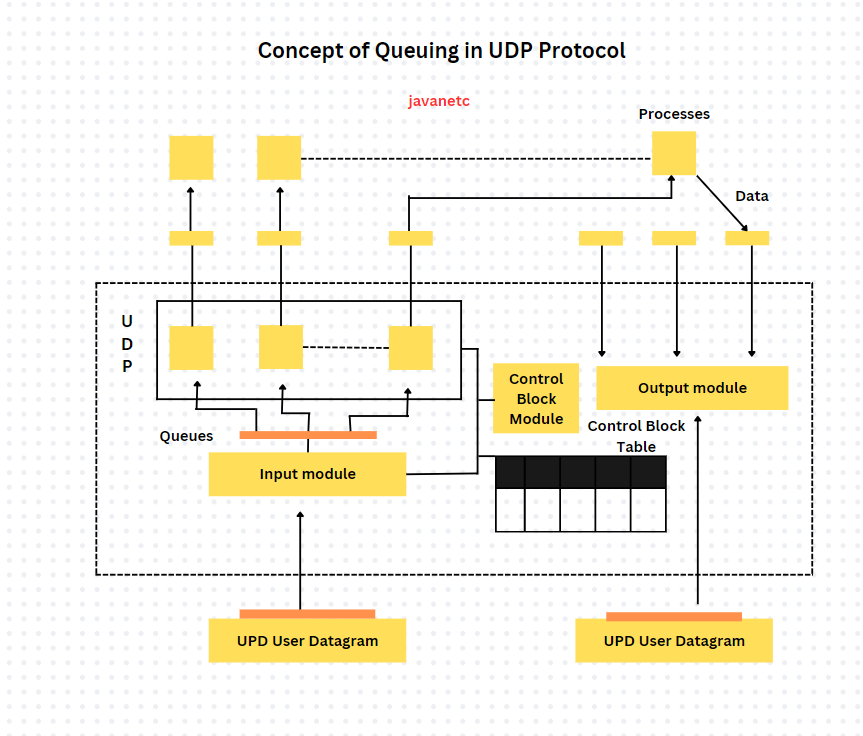Introduction:
The most basic communication protocol at the transport layer is User Datagram Protocol (UDP), offering minimal communication channels. It’s considered unreliable due to its best-effort delivery approach. Unlike other protocols, UDP lacks an acknowledgment mechanism, meaning neither the sender nor the receiver confirms packet receipt or transmission.
Table of Contents
What is User Datagram Protocol (UDP)?
There exist numerous transport layer protocols facilitating process-to-process communication. Today, we delve into one of the simplest within the Transport Layer.
Note: UDP, or User Datagram Protocol, is a connectionless and unreliable transport layer protocol.
Developed by David P. Reed in 1980, UDP operates without the need to establish a connection before data transmission. It provides a set of rules for transmitting data over the internet, with its packets referred to as User Datagram. The UDP protocol involves an 8-byte fixed-size header and serves as an alternative to TCP (Transmission Control Protocol). Users opt for UDP when prioritizing simplicity over the reliability of transmission, especially for sending concise messages.
Working of UDP protocol:
UDP operates by encapsulating data into UDP packets, also known as user datagrams, and adding its header information. Each user datagram includes:
1 .Source port number a 2-byte field indicating the sender’s port number.
2. Destination port number a 2-byte field indicating the recipient’s port number.
3 .Packet length a 2-byte field specifying the total length of the user datagram (header length + data length).
4. Checksum an optional 2-byte field for carrying a checksum.
UDP packets are then sent to their destination encapsulated within an IP packet.

Notably, UDP does not generate acknowledgments for received packets. Therefore, the sender does not wait for acknowledgment of sent packets.
Features of UDP protocol:
Transport layer protocol
User Datagram Protocol (UDP) is classified as a transport layer protocol, known for its attributes of being both unreliable and connectionless.
Connectionless
As a connectionless protocol, UDP does not establish a virtual path prior to data transmission. This lack of connection means that packets can travel via various paths between sender and receiver.
Ordered delivery of data is not guaranteed.
UDP does not ensure the ordered delivery of data, meaning that datagrams can be received in any sequence. To transmit data to the appropriate destination, UDP employs distinct port numbers, which are typically defined within the range of 0 to 1023.
Faster transmission
UDP offers faster data transmission services by eliminating the need for prior connection establishment before sending data. It operates without requiring a virtual path for data transmission.
Acknowledgment mechanism
UDP does not include an acknowledgment mechanism because it operates as a connection-less protocol, thus eliminating the need for handshaking.
Segments are handled independently.
Segments in UDP are handled independently, with each segment taking a different path to reach its destination. Consequently, every UDP packet is treated autonomously, without reliance on the state or progress of other UDP packets.
Stateless
UDP protocol is stateless, meaning that after sending a packet, the sender does not wait for an acknowledgment.
Applications of User Datagram Protocol (UDP):
User Datagram Protocol (UDP) finds applications in various scenarios due to its characteristics. Here are some common uses:
- Simple Request-Response Communication: UDP is suitable for simple request-response communication, especially when dealing with smaller data sizes, as there is minimal concern about error and flow control.
- Multicasting: UDP supports packet switching, making it ideal for multicasting applications where data needs to be sent to multiple recipients simultaneously.
- Routing Update Protocols: Some routing update protocols, such as Routing Information Protocol (RIP), utilize UDP for exchanging routing information among routers.
- Real-Time Applications: UDP is preferred for real-time applications that cannot tolerate uneven delays between received message sections, as it offers faster transmission without the overhead of reliability mechanisms.
- Specific Implementations: Various implementations use UDP as their transport layer protocol, including:
- NTP (Network Time Protocol)
- BOOTP and DHCP (Dynamic Host Configuration Protocol)
- DNS (Domain Name System)
- Quote of the Day Protocol
- NNP (Network News Protocol)
- TFTP (Trivial File Transfer Protocol), RTSP (Real-Time Streaming Protocol), RIP (Routing Information Protocol), among others.
Concept of Queuing in UDP:
In UDP, processes on the network are differentiated using numbers, enabling process-to-process communication. Client-generated processes require services, while server-generated processes provide services. Both types of processes utilize queues: an incoming queue for receiving messages and an outgoing queue for sending messages. These queues are active only when the process is running and are terminated upon process termination. UDP employs the following components for handling UDP packets:

- Input Queue: Each process in UDP utilizes a set of queues for managing UDP packets.
- Input Module: This module, interfacing with the IP, receives user datagrams. It then extracts relevant information from the control block table associated with the same port as the datagram. If a corresponding entry is found in the control block table, the data is enqueued.
- Control Block Module: Responsible for managing the control block table, which contains entries for open ports.
- Control Block Table: Stores entries for open ports, facilitating the identification of relevant ports for incoming user datagrams.
- Output Module: Creates and sends user datagrams.
Advantages of User Datagram Protocol (UDP):
- Minimal Overheads: UDP incurs fewer overheads for data transmission compared to other protocols, making it efficient for certain applications.
- Simplicity: UDP is the simplest transport layer protocol, which contributes to its ease of implementation and understanding.
- Small Packet Size: UDP utilizes smaller packet sizes, which can be advantageous for applications where minimizing packet overhead is essential.
- Faster Delivery: UDP provides faster delivery of data since it lacks an acknowledgment mechanism. Without waiting for acknowledgments, data can be transmitted more quickly.
- Error Detection: UDP employs checksums for error detection, ensuring data integrity during transmission without the complexity of error correction mechanisms found in other protocols.
Disadvantages of User Datagram Protocol (UDP):
- Unreliability: UDP is considered unreliable because it does not guarantee the delivery of packets. Packets may be lost, duplicated, or delivered out of order without any notification.
- Lack of Congestion Control: UDP does not provide congestion control mechanisms, meaning it does not regulate the rate of data transmission based on network congestion levels. This can cause network congestion and packet loss.
- No Order Guarantee: UDP does not guarantee the order of data received, as there is no concept of windowing or sequencing in UDP. This can result in data arriving out of order at the receiver.
- Absence of Flow Control: UDP does not offer flow control mechanisms to regulate the flow of data between sender and receiver. Without flow control, UDP may overwhelm the receiver with data, leading to packet loss or inefficiency.
- Lack of Acknowledgment Mechanism: UDP does not provide an acknowledgment mechanism, so the receiver does not acknowledge the sender for received packets. This means the sender has no way of knowing if packets were successfully delivered, leading to potential data loss or retransmission issues.
Conclusion:
UDP is indeed recognized as the simplest transport layer protocol. It operates as a connectionless and unreliable protocol, lacking error and flow control mechanisms as well as an acknowledgment mechanism. Its packets, termed user datagrams, are foundational to its lightweight and straightforward nature.



